Changes in consumption of omega-3 and omega-6 fatty acids in the United States during the 20th century
- PMID: 21367944
- PMCID: PMC3076650
- DOI: 10.3945/ajcn.110.006643
Changes in consumption of omega-3 and omega-6 fatty acids in the United States during the 20th century
Abstract
Background: The consumption of omega-3 (n-3) and omega-6 (n-6) essential fatty acids in Western diets is thought to have changed markedly during the 20th century.
Objective: We sought to quantify changes in the apparent consumption of essential fatty acids in the United States from 1909 to 1999.
Design: We calculated the estimated per capita consumption of food commodities and availability of essential fatty acids from 373 food commodities by using economic disappearance data for each year from 1909 to 1999. Nutrient compositions for 1909 were modeled by using current foods (1909-C) and foods produced by traditional early 20th century practices (1909-T).
Results: The estimated per capita consumption of soybean oil increased >1000-fold from 1909 to 1999. The availability of linoleic acid (LA) increased from 2.79% to 7.21% of energy (P < 0.000001), whereas the availability of α-linolenic acid (ALA) increased from 0.39% to 0.72% of energy by using 1909-C modeling. By using 1909-T modeling, LA was 2.23% of energy, and ALA was 0.35% of energy. The ratio of LA to ALA increased from 6.4 in 1909 to 10.0 in 1999. The 1909-T but not the 1909-C data showed substantial declines in dietary availability (percentage of energy) of n-6 arachidonic acid, eicosapentaenoic acid (EPA), and docosahexaenoic acid (DHA). Predicted net effects of these dietary changes included declines in tissue n--3 highly unsaturated fatty acid status (36.81%, 1909-T; 31.28%, 1909-C; 22.95%, 1999) and declines in the estimated omega-3 index (8.28, 1909-T; 6.51, 1909-C; 3.84, 1999).
Conclusion: The apparent increased consumption of LA, which was primarily from soybean oil, has likely decreased tissue concentrations of EPA and DHA during the 20th century.
Figures
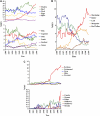
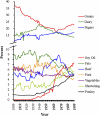
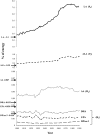


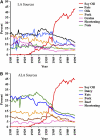


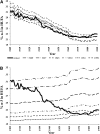

Comment in
-
Twentieth-century trends in essential fatty acid intakes and the predicted omega-3 index: evidence versus estimates.Am J Clin Nutr. 2011 May;93(5):907-8. doi: 10.3945/ajcn.111.014365. Epub 2011 Mar 23. Am J Clin Nutr. 2011. PMID: 21430117 No abstract available.
-
Waste and hydrogenation lower omega-3 and omega-6 fat intake estimates for soybean oil.Am J Clin Nutr. 2011 Oct;94(4):1152-3; author reply 1153-5. doi: 10.3945/ajcn.111.022095. Am J Clin Nutr. 2011. PMID: 21933967 No abstract available.
References
-
- Simopoulos AP. Essential fatty acids in health and chronic disease. Am J Clin Nutr 1999;70(suppl):560S–9S - PubMed
-
- Lands WEM, Libelt B, Morris A, et al. Maintenance of lower proportions of (n−6) eicosanoid precursors in phospholipids of human plasma in response to added dietary (n−3) fatty acids. Biochim Biophys Acta 1992;1180:147–62 - PubMed
-
- SanGiovanni JP, Chew EY, Clemons TE, et al. The relationship of dietary lipid intake and age-related macular degeneration in a case-control study: AREDS Report No. 20. Arch Ophthalmol 2007;125:671–9 - PubMed
-
- Milte CM, Coates AM, Buckley JD, Hill AM, Howe PR. Dose-dependent effects of docosahexaenoic acid-rich fish oil on erythrocyte docosahexaenoic acid and blood lipid levels. Br J Nutr 2008;99:1083–8 - PubMed
-
- Rao JS, Lee HJ, Rapoport SI, Bazinet RP. Mode of action of mood stabilizers: is the arachidonic acid cascade a common target? Mol Psychiatry 2008;13:585–96 - PubMed
Publication types
MeSH terms
Substances
Grants and funding
LinkOut - more resources
Full Text Sources
Other Literature Sources
Medical
Research Materials

